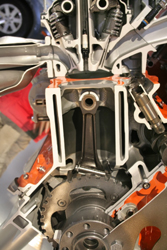Towards a cleaner diesel engine
Diesel engines offer the possibility of combining very high thermal efficiencies with fuel efficiency, which results in low carbon emissions. Their only drawbacks are emissions of nitrogen oxides (NOx) and particulates, which trade against each other in many aspects of the engine's design. For example, very high temperatures in the combustion chamber can help reduce the emission of soot, but produce higher levels of nitrogen oxides. The MINNOX project aimed to identify the most efficient way to achieve the drastic cuts in NOx emissions from diesel engines prescribed in the short and medium term by the legislators. Modelling tools have proven to be valuable towards reducing the experimental work needed for accurately predicting fuel mixture formation and subsequent performance of internal combustion engines. Research conducted at the laboratories of Ford-Werke AG in Germany focused on improving the Computational fluid dynamics (CFD) modelling of wall friction and heat transfer within the engine's cylinder. For this purpose, the circulation of coolant to remove heat from engine components and avoid reaching high temperatures that would be detrimental to lubricating oil were also taken into consideration. Verification of the improved heat transfer model was pursued for idealised flow configurations through comparison with experimental and Large eddy simulation (LES) data. For calculating the gas and water flow, computational grids were generated based on computer-aided design (CAD) models of the combustion chamber components and cooling water jacket around the engine's cylinder. When used to calculate the metal temperatures of a modern, state-of-the-art gasoline engine, the accuracy of the new model coupling Computational fluid dynamics with Finite element (FE) methods was clearly demonstrated.

